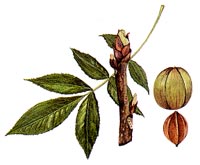Hickory Bluff Project

Come Explore Your Heritage. Dive Into The Past

Issue 4: Hickory at Hickory Bluff.
Hickory Bluff -- the site takes its name from the many hickory trees that grow along the bank overlooking the St. Jones River. It is a picturesque setting. And while we can never know what name the Native American groups gave the site, it may have been something similar to Hickory Bluff. We can make this guess because there is evidence that hickory trees have grown along the banks of the stream for as long as people have visited the site.
Hickory is a common tree in the region, and has been so for thousands of years. Hickories are found in groves, like the one at Hickory Bluff, along with oaks, les, walnuts and other leafy tree species. The wood of the hickory tree was used for fuel, as the identification of charcoal from hearths at the site has shown. Hickory is dense and hard, and it burns very hot - it has been estimated that a cord of hickory wood produces nearly as much heat as a ton of anthracite coal. The hard wood of the hickory was also useful for tool making. It was well-suited for things such as spears or digging sticks, or for hammers or mallets used to beat bark or to flake stone tools.
Early European settlers observed that hickory was the most important nutmeat used by Native American populations at the time the settlers arrived. The nuts were gathered in the early fall. They were crushed and put into water, where the nutmeat was separated from the fibrous shell. The meat was then boiled to extract oils that could be used right away or could be stored for later months. The shell, when dried, was highly flammable and made excellent tinder.
Early historical accounts indicate that hickory had medicinal uses. An infusion or tea was made from the leaves and bark of the tree that was used to treat colds or as a general tonic. Hickory bark was also chewed to relieve mouth sores, and a poultice or dressing was made from the bark to treat arthritis symptoms.
Hickory nuts were probably used by the inhabitants of the Hickory Bluff site throughout its long occupation. A charred nutshell that was excavated from one of the hearth features was sent to the radiocarbon laboratory, where it was dated to around 2900 B.C. This date and several early projectile point styles provide the earliest clear evidence of occupation at the site.








